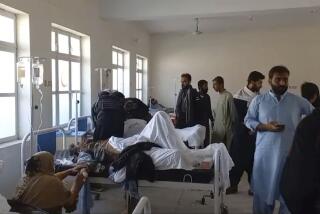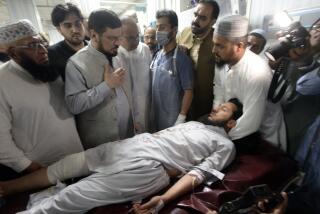Taliban militants find breathing room in slums of Karachi, Pakistan
- Share via
Reporting from Karachi, Pakistan — In Karachi’s Baldia neighborhood, a working-class mix of Pashtun and other Pakistanis, it took an accidental explosion amid piles of suicide vests and grenades to unearth a cell of Taliban militants in a house that neighbors believed sheltered a quiet Pashtun family.
“We thought they were fruit sellers,” said Mohammed Zahid, 24, who lives across the path from the heavily damaged house. Police said the Jan. 8 blast killed seven Taliban militants who had been planning to attack a Baldia police training center.
“They appeared to be good Muslims. We had no idea they were involved in anything like this,” Zahid said.
The dense warrens of cinder-block huts in Karachi’s sprawling ethnic Pashtun neighborhoods make ideal hide-outs for Afghan and Pakistani Taliban militants looking for a break from the fighting or for a base from which to strategize and muster up new financing. The Taliban are Pashtun, and they easily melt into the teeming masses that choke dusty swaths of bazaar storefronts and alleyways.
The arrest of the Afghan Taliban’s second in command, Mullah Abdul Ghani Baradar, in Karachi in late January spotlighted this vast, chaotic city’s role as a Taliban refuge. And because military offensives in Pakistan’s Swat Valley and South Waziristan regions have led Taliban militants to flee in growing numbers to Karachi, in Sindh province, authorities’ focus on Pakistan’s largest city as a hunting ground for extremists is also likely to grow.
“We don’t deny their presence here, and our search for them goes on,” said Collin Kamran Dost, special home secretary for Sindh province. “But the city is so huge, and there are so many slums. The face of a Taliban is the same as the face of a Pakistani Pashtun. And we have more than 1.5 million Afghanis living here. So it’s difficult to determine whether someone is a Taliban member or a peaceful citizen.”
A recent spate of high-profile arrests -- including Baradar’s capture, raids that nabbed nine Al Qaeda-linked militants Feb. 17 and Thursday’s arrest of Abdul Aziz, a militant with ties to Qari Hussain Mahsud, the Pakistani Taliban’s top trainer of suicide bombers -- points not only to improved Pakistani cooperation with the U.S. but also to hope in Washington that Pakistan will show new vigor in looking for Afghan Taliban and Al Qaeda commanders on its soil.
The arrests indicate how key militant commanders have tried to embed themselves deep in the slums of Karachi, a city of more than 16 million people.
Baradar, who was the Taliban’s military chief, is believed to have had more responsibility for the insurgency’s overall operations than the Taliban’s supreme leader, the reclusive Mullah Mohammed Omar.
Among the nine people arrested in raids in Karachi in February was an alleged Al Qaeda-linked militant responsible for overseeing foreign fighters deployed to Pakistan’s tribal areas along the border with Afghanistan.
Members of the Pakistani Taliban have used Karachi as a haven for years, slipping into the city for a month or more to rest or seek medical treatment before returning to their stronghold in the northwestern tribal belt.
Lately, as the southern city of Quetta has become increasingly unsafe for the Afghan Taliban leadership, its members have also been making the trek to Karachi, to establish new cells that can provide refuge, experts say.
Militants had spared the city of the suicide bombings and other violence seen in major Pakistani cities. However, authorities believe that bombings that hit Karachi in December and February suggest that the Pakistani Taliban has added the city to its list of targets.
A bomber killed 43 people on Dec. 28 when he blew himself up in the middle of a procession observing the Shiite Muslim holy day of Ashura. Five weeks later, two bombs targeting a hospital and a bus filled with Shiites killed at least 22 people. The Pakistani Taliban, which is made up of Sunni Muslims, claimed responsibility for both attacks.
“They’re reacting to the loss of [South] Waziristan,” Dost said. “It’s as simple as that.”
A primary reason the Taliban comes to Karachi is to build up supplies of cash to help fund the insurgency. Bank robberies, kidnappings and extortion have become staples of the militants’ fundraising, authorities say. But they also rely heavily on cash solicited through the hundreds of madrasas, or religious schools, that dot the city.
Kamran Akhtar, the nazim, or administrative chief, of the Baldia neighborhood, said that of his district’s 166 madrasas, 112 support the Taliban.
“To a large extent, the militants raise funds through Baldia madrasas,” Akhtar said.
He believes the Taliban fighters in Baldia number in the hundreds. As nazims have done in other neighborhoods that are heavily Pashtun, Akhtar has organized a network of street informants -- a Karachi version of a Neighborhood Watch group -- who relay tips to police about suspected militants and their activities. Many of the tipsters are Pashtun.
“There are Pashtuns giving us information, and other Pashtuns providing the Taliban shelter,” Akhtar said.
In Sohrab Goth, another dirt-poor Karachi neighborhood with a high concentration of Pashtuns, the Taliban extort money from construction equipment and trucking companies whose owners have tribal ties to Waziristan, police and residents said.
“The Taliban come here mostly to raise funds, and yes, they have their financiers here, wealthy Pashtun businessmen who help finance the insurgents,” said Ismail Khan Mahsud, president of the local student wing of the Awami National Party, a Pashtun political party.
alex.rodriguez @latimes.com
More to Read
Sign up for Essential California
The most important California stories and recommendations in your inbox every morning.
You may occasionally receive promotional content from the Los Angeles Times.










